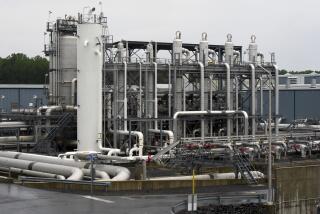Obama’s visit puts spotlight on wind project
- Share via
WASHINGTON AND MARTHA'S VINEYARD, MASS. — For at least one more summer, vacationers on Martha’s Vineyard won’t be able to gaze across the water and see, far off on the horizon, the churning blades of offshore wind turbines -- no matter how badly the island’s most famous current vacationer would like.
President Obama, now summering on the Massachusetts island with his family, is still at least a year away from seeing turbines take root anywhere off the U.S. coast, even though his administration promised to make offshore wind a priority and developers are lining up to string wind farms up and down the Atlantic seaboard.
His administration, delayed by controversy and red tape, has yet to grant a single permit for wind or solar development on public land, onshore or off.
Administration officials say the first solar permits won’t come until at least next year and the first offshore wind farm is probably a year or two away.
The officials say they’ve moved quickly to clear the “regulatory underbrush” untended by a George W. Bush administration team that spent little money or effort to develop wind and solar energy on public land.
“We’re cooking, and we’re excited about it,” said Deputy Interior Secretary David Hayes, who runs the department’s renewable-energy development push. “We are going to see this commercial development occurring, both offshore and solar. You will continue to see tangible progress toward that.”
The project proposed for Nantucket Sound off Martha’s Vineyard is a case in point.
For more than eight years, investors on all sides -- some with interests in the new sources of energy and others making money off old ones -- have been fighting over the proposed Cape Wind Project.
The project would provide the majority of the power on Cape Cod and nearby islands, designers say, harnessing wind five to 10 miles offshore and transmitting it via cables under the sea floor back to land. Roughly 130 turbines and an electric service platform would take up 24 square miles within the sound.
The windmills would be visible from the mainland as well as Martha’s Vineyard on a clear day.
That idea warms the hearts of people like Barbara Hill, a Cape Cod resident and executive director of Clean Power Now, a nonprofit.
“They’ll be like masts on the horizon,” she said of the turbines. “It’s this perfect relationship between technology and nature. . . . It’s something that’s going to change the energy paradigm in this country.”
But critics worry about the effect on the environment, boaters and fishermen who make their living on the shoal where the turbines would be constructed. Native Americans on the sound, who call themselves “people of the first light,” say the mills would obstruct their view of the sunrise.
“It would interfere with the natural beauty, the essence of why people come here,” said Audra Parker, executive director of the nonprofit Alliance to Protect Nantucket Sound. “They don’t come for an industrial landscape. They come to get away from that.”
The controversy doesn’t explain why the project remains probably two years from reality: bureaucracy.
When the proposal, the first of its kind, was made, there was no government agency prepared to consider its merits or issue permission to begin it. After years of wrangling, that authority rests with the Interior Department, which boosted offshore wind development from federal obscurity to the top of its priorities this year.
Soon after Interior Secretary Ken Salazar took office, he began touting the possibility that offshore wind could theoretically provide enough electricity to meet the nation’s entire current demand. He settled a long-running jurisdictional fight with the Federal Energy Regulatory Commission over offshore power and issued the first federal rules for offshore wind development.
With those efforts, Interior and some local officials say, wind projects are moving closer to fruition off New Jersey, Delaware, Rhode Island and other Northeast states. But those projects still must clear permitting processes and environmental reviews, and Hayes said none would come online for at least a year.
He also said solar-panel construction could start early next year on tracts of the Southwest the department was pushing hard to lease.
Meanwhile, Interior has pressed ahead with oil and gas drilling on public lands. Through mid-August, it had offered for sale more acres of dry-land drilling than the Bush administration had at the same point in 2008. If not for a court order that blocked a proposed lease sale in the Beaufort Sea off Alaska, the department would be close to Bush’s drilling pace offshore as well.
Republicans are prodding the administration to move faster on every domestic energy front, including windmills, solar farms and more drilling.
Republicans on the House Natural Resources Committee chided Obama on an offshore-wind-themed mock postcard released last week in advance of the president’s vacation.
“Don’t let this energy opportunity breeze by you!” they wrote.
--
cparsons@latimes.com
More to Read
Sign up for Essential California
The most important California stories and recommendations in your inbox every morning.
You may occasionally receive promotional content from the Los Angeles Times.













